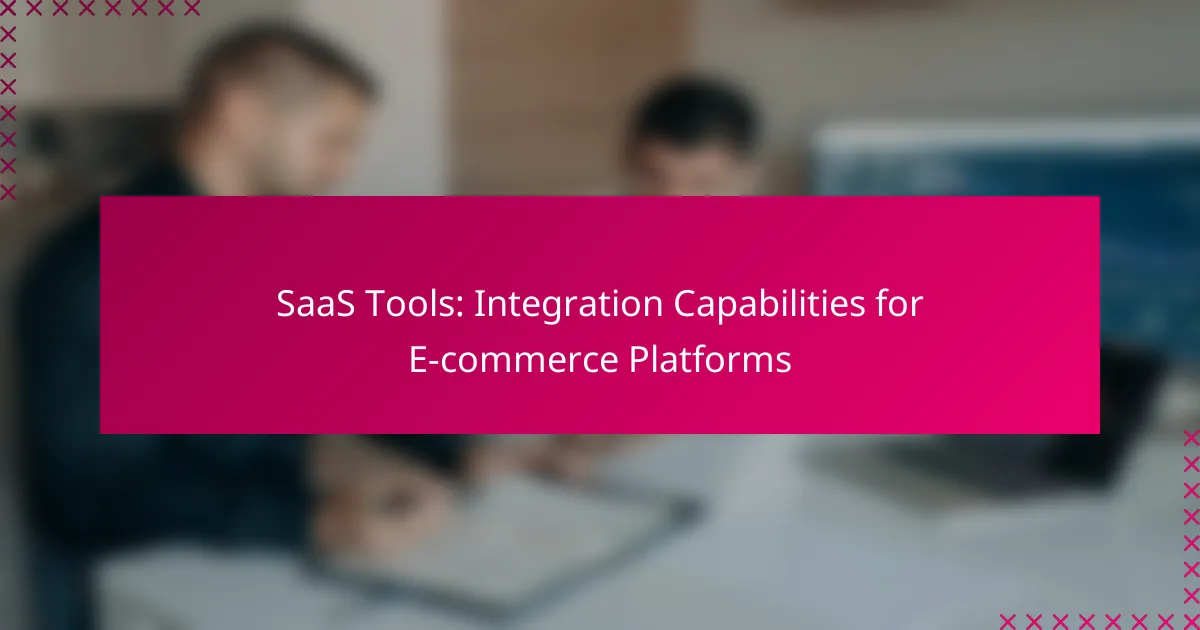SaaS tools designed for e-commerce integration play a crucial role in optimizing business operations and enhancing customer experiences. By offering seamless connectivity between platforms like Shopify, BigCommerce, and WooCommerce, these tools enable efficient data management and streamline processes, ensuring that businesses can respond effectively to customer needs.
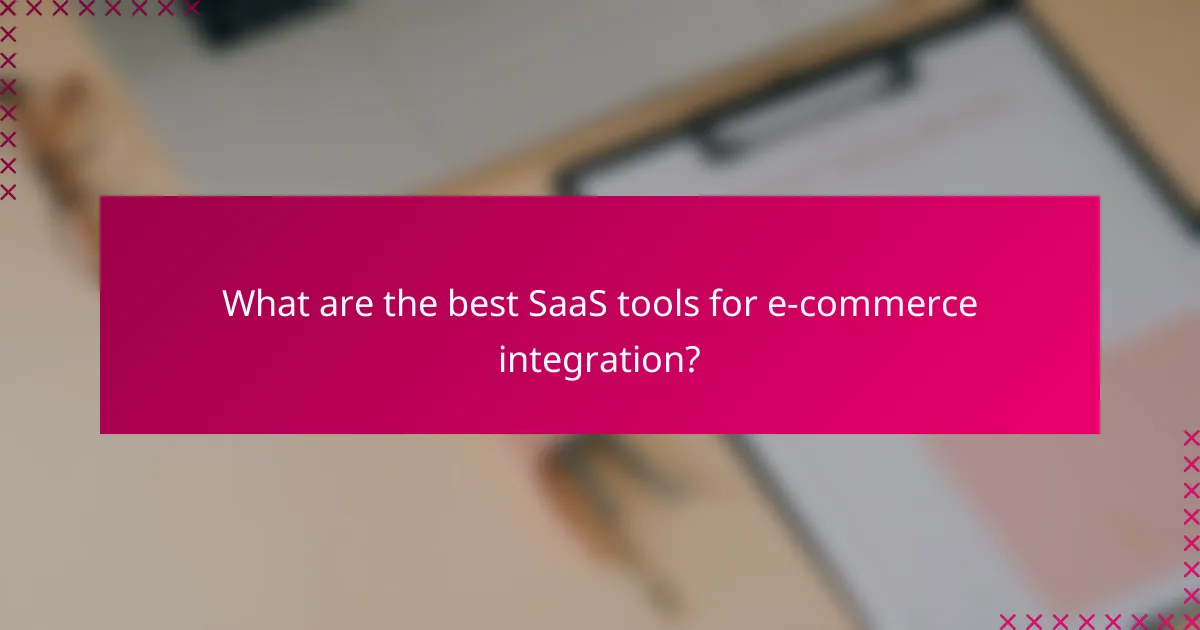
What are the best SaaS tools for e-commerce integration?
The best SaaS tools for e-commerce integration streamline operations, enhance customer experiences, and improve data management. Key platforms include Shopify, BigCommerce, WooCommerce, Magento, and Salesforce Commerce Cloud, each offering unique features and capabilities tailored to different business needs.
Shopify
Shopify is a leading e-commerce platform known for its user-friendly interface and extensive app ecosystem. It supports a wide range of integrations with payment gateways, shipping providers, and marketing tools, making it easy to customize your online store.
Consider using Shopify’s built-in integrations for popular services like Mailchimp or QuickBooks, which can automate email marketing and accounting tasks. This can save time and reduce manual errors.
BigCommerce
BigCommerce is designed for scalability and offers robust integration capabilities for larger businesses. It supports various third-party applications, including ERP systems and CRM tools, which can enhance inventory management and customer relationship strategies.
Utilizing BigCommerce’s API can help businesses create custom integrations tailored to specific operational needs. This flexibility is particularly beneficial for companies with unique workflows or specialized requirements.
WooCommerce
WooCommerce is a popular plugin for WordPress that transforms a standard website into a fully functional e-commerce store. It offers numerous integration options for payment processors, shipping solutions, and marketing platforms.
When using WooCommerce, leverage its extensive library of plugins to enhance functionality. Be cautious about plugin compatibility and performance, as too many can slow down your site.
Magento
Magento is a powerful e-commerce platform suitable for medium to large businesses requiring advanced customization. It supports various integrations, including payment gateways, shipping services, and marketing tools, allowing for a tailored shopping experience.
Consider the Magento Marketplace for finding reliable extensions that can enhance your store’s capabilities. However, be prepared for a steeper learning curve and higher hosting costs compared to simpler platforms.
Salesforce Commerce Cloud
Salesforce Commerce Cloud is an enterprise-level solution that integrates seamlessly with Salesforce’s CRM. This platform is ideal for businesses looking to unify customer data across channels and enhance personalized marketing efforts.
Utilizing Salesforce’s AI capabilities can provide insights into customer behavior, helping to optimize sales strategies. Ensure your team is trained on the platform to fully leverage its advanced features and capabilities.
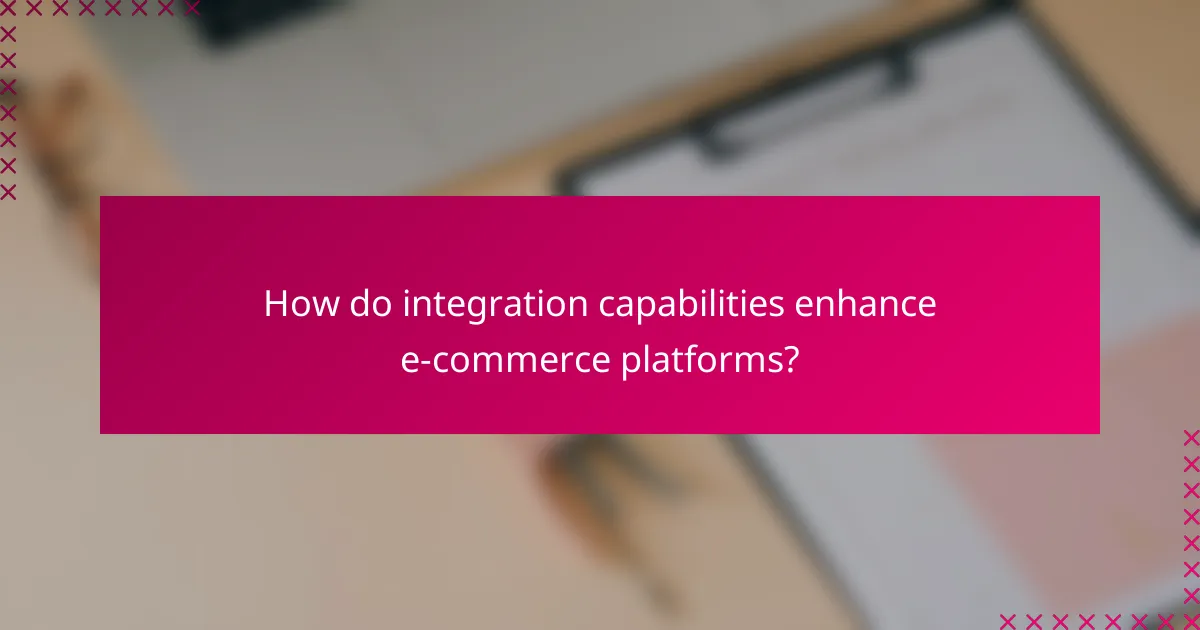
How do integration capabilities enhance e-commerce platforms?
Integration capabilities significantly enhance e-commerce platforms by enabling seamless connections between various software tools and services. This connectivity streamlines processes, improves customer interactions, and ensures data consistency across systems.
Streamlined operations
Streamlined operations are achieved through the automation of repetitive tasks and the elimination of manual data entry. By integrating tools like inventory management, payment processors, and shipping services, businesses can reduce operational bottlenecks and improve efficiency.
For example, an integrated inventory management system can automatically update stock levels in real-time as sales occur, preventing overselling and improving order fulfillment. This leads to faster processing times and a more agile business model.
Improved customer experience
Integration capabilities directly contribute to an improved customer experience by providing a cohesive shopping journey. When e-commerce platforms connect with customer relationship management (CRM) systems, businesses can personalize marketing efforts and enhance customer support.
For instance, integrating chatbots with e-commerce sites allows for immediate customer assistance, addressing inquiries and issues without delay. This responsiveness can lead to higher customer satisfaction and increased loyalty.
Data synchronization
Data synchronization ensures that all systems reflect the same information, which is crucial for accurate reporting and decision-making. When e-commerce platforms integrate with analytics tools, businesses can gain real-time insights into sales trends and customer behavior.
Regular synchronization minimizes discrepancies between sales data and inventory levels, which is vital for maintaining operational integrity. Businesses should implement automated sync processes to keep data consistent across platforms, reducing the risk of errors and enhancing overall performance.
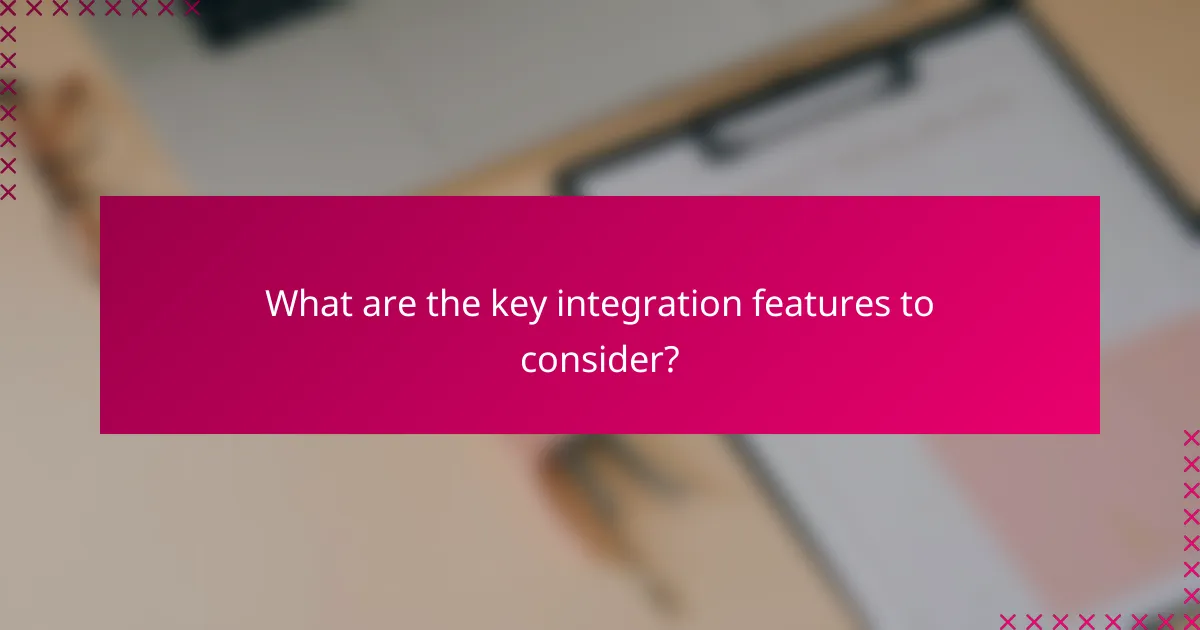
What are the key integration features to consider?
Key integration features for e-commerce platforms include API access, third-party app compatibility, and real-time data updates. These elements ensure seamless connectivity and efficient data flow between various software solutions, enhancing overall operational efficiency.
API access
API access is crucial for integrating SaaS tools with e-commerce platforms. A robust API allows for the exchange of data between systems, enabling functionalities such as inventory management, order processing, and customer relationship management. When evaluating API access, consider factors like documentation quality, authentication methods, and rate limits.
Look for APIs that support REST or GraphQL standards, as these are widely adopted and facilitate easier integration. Additionally, ensure that the API can handle the expected volume of requests, especially during peak shopping seasons.
Third-party app compatibility
Third-party app compatibility determines how well your e-commerce platform can work with external tools and services. This includes payment gateways, shipping solutions, and marketing automation software. A platform that supports a wide range of third-party applications can significantly enhance functionality and user experience.
To assess compatibility, check for pre-built integrations or marketplaces where you can easily find and install apps. Ensure that the platform allows for customization if needed, as this can help tailor solutions to specific business needs.
Real-time data updates
Real-time data updates are essential for maintaining accurate information across all integrated systems. This feature allows changes in inventory, orders, or customer data to be reflected instantly, reducing the risk of errors and improving customer satisfaction. Look for solutions that offer webhooks or similar technologies to facilitate these updates.
When implementing real-time updates, consider the impact on system performance and data consistency. Aim for solutions that can handle high transaction volumes without lag, especially during busy periods like sales or holidays.
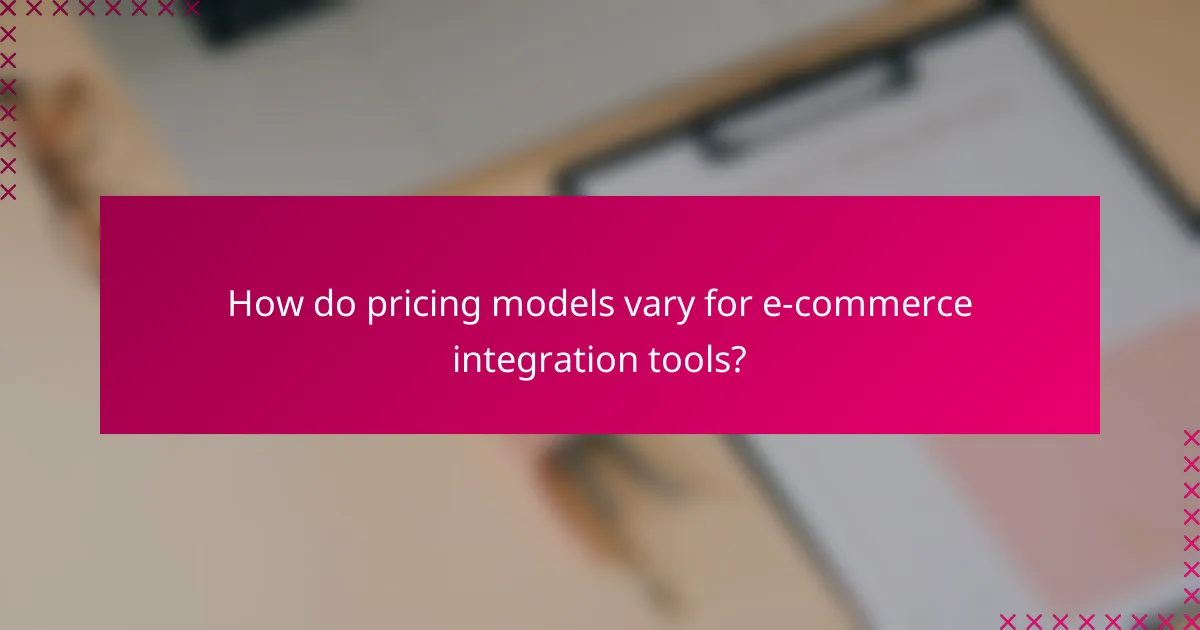
How do pricing models vary for e-commerce integration tools?
Pricing models for e-commerce integration tools can differ significantly, affecting how businesses budget for these essential services. Common models include subscription-based, pay-per-use, and tiered pricing plans, each with its own advantages and considerations.
Subscription-based pricing
Subscription-based pricing involves paying a recurring fee, typically monthly or annually, for access to the integration tool. This model often includes updates and customer support, making it a stable option for businesses that require consistent functionality.
For example, a small e-commerce store might pay around $30 to $200 per month depending on the features included. This model is beneficial for businesses that prefer predictable costs and regular service enhancements.
Pay-per-use pricing
Pay-per-use pricing charges businesses based on their actual usage of the integration tool, which can be advantageous for those with fluctuating needs. This model allows companies to scale costs according to their transaction volume or API calls.
For instance, a business might pay $0.10 per transaction processed through the integration. This approach can be cost-effective for smaller businesses or those with seasonal sales spikes, but it may lead to higher costs during peak periods.
Tiered pricing plans
Tiered pricing plans offer different levels of service at varying price points, allowing businesses to choose a package that aligns with their needs. Each tier typically includes a set number of features, integrations, or usage limits.
For example, a basic tier might start at $50 per month for essential features, while a premium tier could cost $300 per month with advanced analytics and priority support. This model provides flexibility, enabling businesses to upgrade as they grow without switching providers.
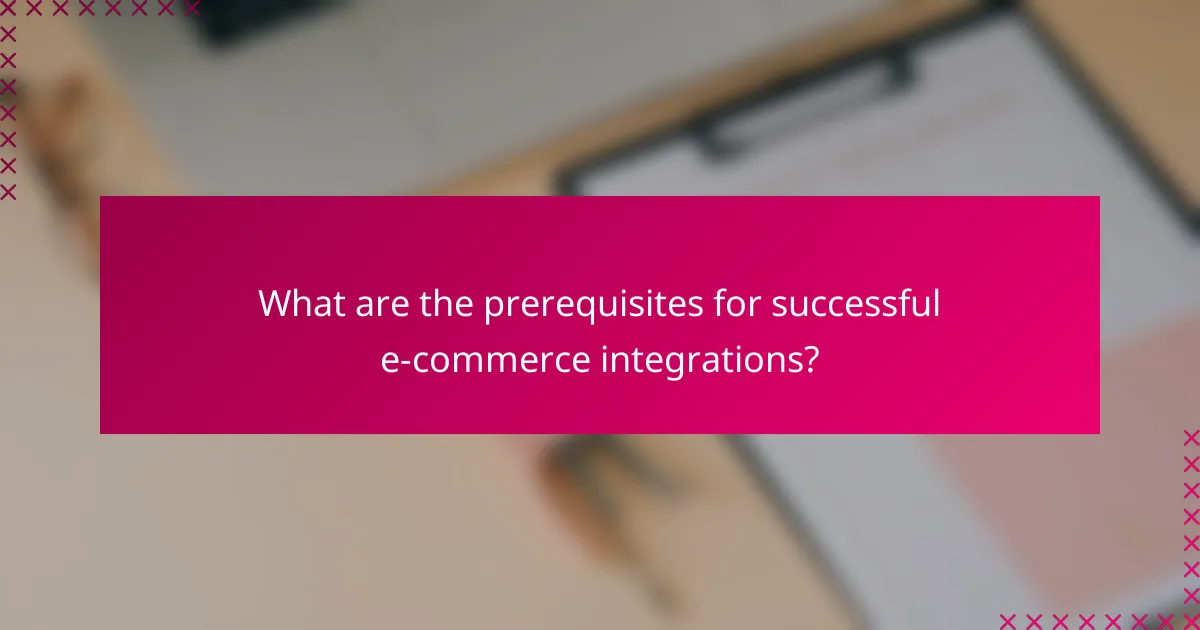
What are the prerequisites for successful e-commerce integrations?
Successful e-commerce integrations require a clear understanding of your business needs, the right technology stack, and effective communication between systems. Ensuring compatibility between platforms and having a well-defined integration strategy are crucial for seamless operations.
Understanding your business needs
Before integrating any tools, identify the specific challenges and goals of your e-commerce operation. Consider factors such as inventory management, customer relationship management, and payment processing. A thorough assessment will guide you in selecting the right SaaS tools that align with your objectives.
For example, if your goal is to enhance customer experience, focus on integrations that improve user engagement and streamline checkout processes. Prioritize features that directly address your business needs to maximize the effectiveness of the integration.
Choosing the right technology stack
Selecting compatible technologies is essential for successful e-commerce integrations. Ensure that your chosen SaaS tools can communicate effectively with your existing platforms, such as your e-commerce site, CRM, and ERP systems. Look for tools that offer APIs or built-in connectors to facilitate this communication.
Consider using cloud-based solutions that can easily scale with your business. This flexibility allows you to adapt to changing market conditions without significant disruptions. Evaluate different options based on their integration capabilities and user reviews to make informed decisions.
Establishing effective communication between systems
Effective communication between integrated systems is vital for maintaining data integrity and operational efficiency. Implement protocols for data synchronization, ensuring that information flows seamlessly between platforms. Regularly monitor data exchanges to identify and resolve any discrepancies.
Utilize tools that provide real-time updates and alerts for any integration issues. This proactive approach helps prevent potential disruptions in your e-commerce operations, allowing you to address problems before they impact customer experience.
